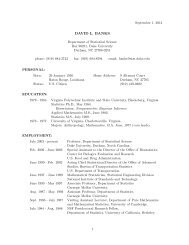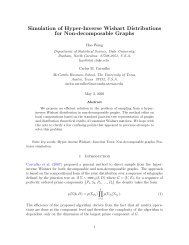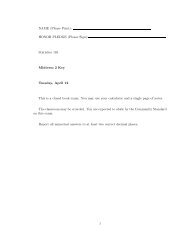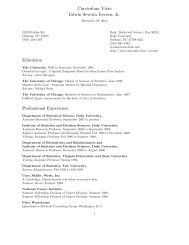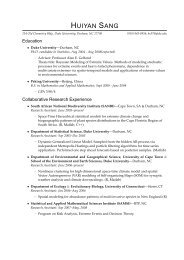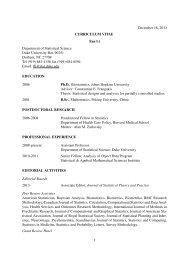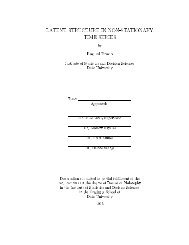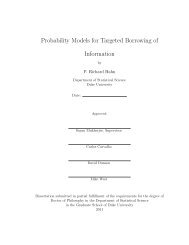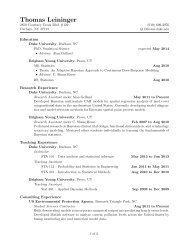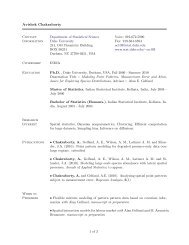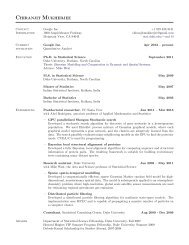Bayesian Dynamic Factor Models - Department of Statistical Science ...
Bayesian Dynamic Factor Models - Department of Statistical Science ...
Bayesian Dynamic Factor Models - Department of Statistical Science ...
You also want an ePaper? Increase the reach of your titles
YUMPU automatically turns print PDFs into web optimized ePapers that Google loves.
els by implementing sequential portfolio allocations based on forecast means and variances <strong>of</strong> FX<br />
series.<br />
5.1 Portfolio allocation rule<br />
We base the following forecasting strategy and portfolio allocation rules. Suppose that we<br />
initially have the first n = 880 observations <strong>of</strong> our FX data analyzed above. That is, in our FX data<br />
set, we have the remaining time intervals, a total <strong>of</strong> 100 business days, as periods <strong>of</strong> investment<br />
study. After observing the closing rates on the business day t − 1 (≥ n), one-step-ahead forecasts<br />
for means and variances, denoted by (g t, Q t), <strong>of</strong> y t are computed via the MCMC based on draws<br />
from one-step-ahead predictive posterior distribution using the available data, y 1:t−1. Resources<br />
are allocated according to a vector <strong>of</strong> portfolio weights wt optimized by a specific allocation rule<br />
described below. The realized portfolio return at time t is rt = w ′ ty t. The portfolio is reallocated<br />
on each business day based on one-step-ahead forecasting computed via the MCMC given updated<br />
data. We fix the total sum invested on each business day by restricting w ′ t1 = 1.<br />
We use the traditional optimization technique for portfolio allocation originally developed by<br />
Markowitz (1959). Given a fixed scalar return target m, we optimize the portfolio weights wt,<br />
by minimizing the one-step ahead variance <strong>of</strong> returns among the restricted portfolios whose one-<br />
step-ahead expectation is equal to m. Specifically, at time t, we minimize an ex-ante portfolio<br />
variance w ′ tQtwt, subject to w ′ tgt = m, and w ′ t1 = 1. The solution <strong>of</strong> this quadratic minimization<br />
problem is derived via Lagrange multipliers as w (m)<br />
t = Q−1 t (atgt + bt1), where at = 1 ′ Q −1<br />
t e, and<br />
bt = −g ′ tQ −1<br />
t e, where e = (1m − gt)/d, and d = (1 ′ Q −1<br />
t 1)(g′ tQ −1<br />
t gt) − (1 ′ Q −1<br />
t gt) 2 . This optimal<br />
portfolio is called as efficient frontier. In our analysis, we also consider a target-free minimum-<br />
variance portfolio, whose solution is given by w∗ t = Q −1<br />
t 1/(1′ Q −1<br />
t 1). We implicitly assume that we<br />
can freely reallocate the resources to arbitrary long or short positions across the currencies without<br />
any transaction cost.<br />
In addition to one-step-ahead prediction, we also examine the analysis from five-step-ahead<br />
forecasts. Every five business days, the posterior predictive distribution <strong>of</strong> five-step horizons,<br />
(y t, y t+1, . . . , y t+4), is computed via MCMC based on the available data y 1:t−1. This experiment<br />
assumes a possible situation that investors allocate their resource every business day based on<br />
weekly-updated forecasts.<br />
5.2 Model comparisons<br />
We consider the following three models from the class <strong>of</strong> LTDFM:<br />
• LM-AF: Local means, and autoregressive factors.<br />
• LM-IF: Local means, and time-independent factors (Φ = O).<br />
16






